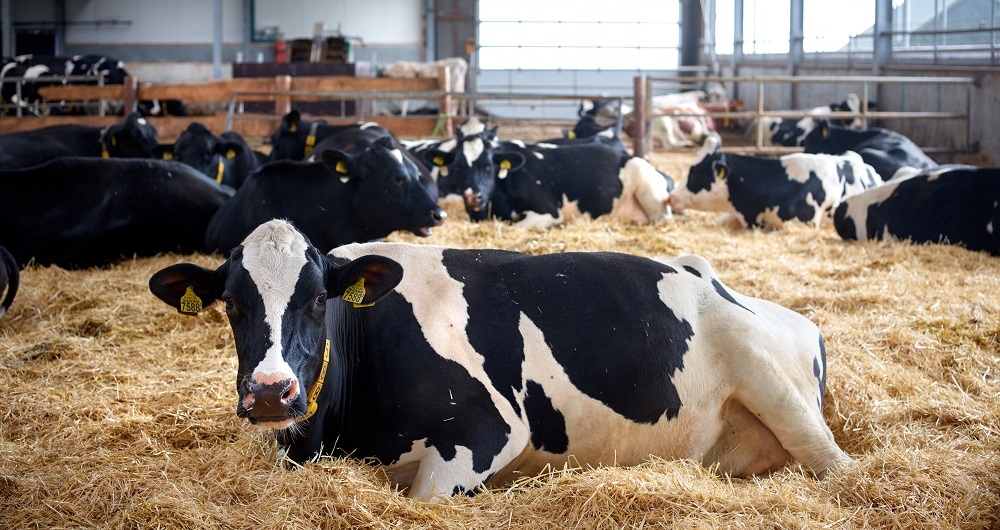



How do you measure emissions in an open barn?
Much effort is being made within the Dutch livestock sector to reduce ammonia and methane emissions. But, how do you measure these emissions? How do we know what the current concentrations are? And, even more to the point, how can you measure emissions in an open barn? Doesn’t everything just – litterally - evaporate into thin air?Karin Groenestein starts grinning immediately when confronted with this question. “Ah yes! This question is dead-on!” Karin is a researcher at Wageningen Livestock Research and is, directly and indirectly, involved in many of the Integrated Approach (Integraal Aanpakken) projects, aimed to reduce ammonia and methane from the livestock sector: “To start off with, it is important to know what exactly emission is. To keep it simple, the rule of thumb is: emission = concentration x ventilation”, Karin says.
In order to calculate this, we need to know the concentration of ammonia or methane in a barn. In short: how much of these substances are in the barn? Moreover, we need to know about ventilation, which is the amount of air that flows through the barn. Because polluted air can only be expelled from the barn if fresh air is let in. Otherwise, the emission is zero.
Concentration
Good sensors and a proper measuring method are the key to reliable data, the researcher explains. “As is the case in your private life: buy cheaply, pay dearly. Cheap sensors are generally less accurate, and accuracy is precisely what is needed. Particularly in naturally ventilated barns such as dairy cattle barns. We need to measure the difference between the air outside -which may also contain ammonia- and the air inside, which contains more ammonia. The difference is sometimes minimal, which makes using an accurate sensor essential.
Karin goes on to explain that each reading is taken twice. “The numbers tell the tale. So, if all goes well, both readings are the same. If so, the data is reliable.”
In addition to sensors, the researchers also measure the ammonia concentration by forcing barn air through a bottle containing an acid. This acid extracts the ammonia from the barn air. The ammonia content in the acid is then measured in the lab. Since they know how many litres of barn air has been 'bubbled' in the bottle, the researchers can calculate the concentration of ammonia in the barn.
Images: Researcher Hendrik Jan van Dooren seals the bottles used to measure ammonia.
Measuring greenhouse gasses such as nitrous oxide and methane is done slightly differently. The scientists use the so-called lung method: a large container with a vacuum bag inside. Karin: “When we open the valve in the bag, it will draw in barn air during 24 hours. We then analyse the air in the lab. There, we have expensive measuring equipment that can determine exactly how much methane and nitrous oxide the air contains.”
Ventilation
“Now we know the levels of ammonia, methane and nitrous oxide in the barn air. But this is not the same as emission. We need the second component for our calculation: ventilation. Knowing how much air leaves the barn is essential. In mechanically ventilated barns, this is simple enough. You just measure the volume of air that runs through the ventilation shaft”, Karin explains. “This is not an option in a dairy cattle barn, as these are often naturally ventilated, with open sides.”

“We had to think of a work-around. We know how much CO2 a cow exhales. So, if there are 100 heads of cattle in the barn, in this hypothetical case, there should be 5000 ppm of CO2 in the barn air if there was no ventilation at all. The barn is, however, ventilated, so we measure the concentration of CO2 in the barn. If this is, say, 500 ppm CO2, we know that the air has been diluted tenfold. This means that ten times the barn volume in fresh air has passed through the building. And with it, methane and ammonia.”
“Now, we have the two components we need for our calculation”, Karin says. “We know the concentration, and we know the ventilation. This allows us to calculate the emission. This is a slightly simplified explanation; reality is a bit more complicated. Aspects such as temperature, wind velocity, barn hygiene and concentration in the outside air all influence the concentration in the barn, and the airflow.
Measuring emissions is a rather precise job and essential for integrated solutions in cattle farming!”





